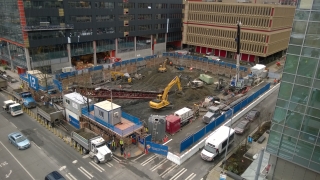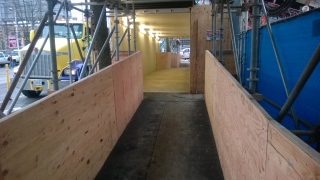|
Subscribe / Renew |
|
|
Contact Us |
|
| ► Subscribe to our Free Weekly Newsletter | |
| home | Welcome, sign in or click here to subscribe. | login |
Construction
| |

April 9, 2015
HSW untangles the maze for pedestrians who just want to get past jobsites safely
Special to the Journal
As Seattle's downtown continues to grow with new construction and large-scale renovations, the Seattle Department of Transportation is keeping an eye on the perimeters of construction sites.
City officials want to see smooth passage around construction sites not only for cars, buses and bicycles, but also for pedestrians. The city is focusing on reducing the impacts of construction on local businesses and pedestrians.
At most construction sites, pedestrians are faced with a maze of choices — none of which may appear easy at first glance.
Pedestrians looking for the quickest route between Point A and Point B sometimes face closed sidewalks or the prospect of navigating sidewalks buzzing with nearby construction activity. They walk in tight corridors that don't always feel safe from the construction, while negotiating changes in grade and terrain and watching for temporary signage.
While the city wants to keep development projects running smoothly, a new initiative called Access Seattle has the goal of studying what the city calls “mobility impacts” from construction and creating a more pedestrian friendly environment amid the bustle of excavation and construction.
“Contractors are responsible for maintaining the safety of the construction sites,” said Ken Ewalt, SDOT site coordinator in the Access Seattle Construction Hub Coordination Program. “We're looking for ways to maintain pedestrian access while the building sites are active.”
The measures could also reduce the possibility of pedestrian injuries or fatalities near construction sites.
At the 1007 Stewart project, at 10th Avenue and Stewart Street, general contractor Howard S. Wright (a Balfour Beatty company) is using new methods to keep pedestrians safer and flowing quickly around the site of the 21-story office building.
Brian Sorensen, a senior loss prevention manager with Howard S. Wright, said his company makes safety a key priority for workers and pedestrians around jobsites.
“This is about making safety personal,” Sorensen said. “We influence the public so much, we want to make sure we protect them.”
Howard S. Wright is using water-filled plastic Jersey barriers to protect pedestrians on the Terry Avenue side of the project.
Typically, construction companies use cones or pylons to form a barrier between pedestrians and the street, but Sorensen said the waist-high barriers are superior to cones in protecting pedestrians.
While construction companies sometimes close sidewalks during construction, at the 1007 Stewart project HSW is keeping the Stewart Street side open 24/7 with a tunnel for pedestrians.
Sorensen said the “steel connection box” allows pedestrians safe passage while workers excavate and transfer dirt to dump trucks.
HSW superintendent Ed Muscat said the tunnel ensures safety for everyone, including construction workers.
“Zero Harm is our safety model,” he said referring to HSW's safety program, “and that's what we strive for. Using the tunnel, pedestrians can move safely and we can still do our work — instead of closing the sidewalk.”
Other pedestrian safety measures include jobsite access doors that open into the jobsite rather than outward, and what Muscat called “trip-free” pedestrian walkways that keep the barrier fence-footings away from pedestrians' feet.
Ewalt said the city worked with Howard S. Wright to implement the pedestrian tunnel at 1007 Stewart. But he added that there will be times when sidewalks have to be closed, such as when they are replaced.
“Before, we were just allowing contractors to close sidewalks in any way they proposed to,” he said.
Ewalt said the Construction Hub Coordination Program is designed to encourage innovative solutions — such as those HSW is using to keep sidewalks open — on projects in the downtown hub, and eventually city-wide.
“Public access is a big thing,” Ewalt said. “With big change comes a lot of challenges. Contractors and the city are figuring out how to work together.”
Excavation at 1007 Stewart wrapped up last week, and Muscat said construction should be complete in October 2016.
Previous columns:
- Bullitt Center: ‘huge, bold bet’ pays off — even in cloudy Seattle, 04-02-2015
- Alaska mine will use new way to extract rare earth elements without polluting, 03-26-2015
- City Light to remove dam in far reaches of the state, 03-19-2015
- Woodworker builds camp wagon like those used by Basque sheepherders, 03-12-2015
- Tower crane cameras make jobsites safer, 03-05-2015
- 'Incredible vision of water' draws developer to 23-acre site near Willamette Falls in Oregon, 02-26-2015
- University of Oregon's $50M rec center makeover: rock-climbing gym, new swimming pools, media wall, 02-19-2015
- Building a school ‘in the teeth of the North Pacific’ brings unusual challenges -- like rain that falls up, 02-12-2015




